While many of the earlier chapters of this volume have explored the physics and technology behind non-contact temperature measurement, now it's time to delve into the wide array of products that are available to take advantage of radiation phenomena--and how they're applied to industrial use.
Non-contact temperature sensors allow engineers to obtain accurate temperature measurements in applications where it is impossible or very difficult to use any other kind of sensor. In some cases, this is because the application itself literally destroys a contact-type sensor, such as when using a thermocouple or resistance temperature detector to measure molten metal. If the electrical interference is intense, such as in induction heating, the electromagnetic field surrounding the object will cause inaccurate results in conventional sensors. A remote infrared sensor is immune to both problems.
For maintenance, no other sensor is able to provide long-distance, non-contact temperature measurements needed to find hot spots or trouble areas in distillation columns, vessels, insulation, pipes, motors or transformers. As a maintenance and troubleshooting tool, it's difficult to beat a hand-held radiation thermometer.
Although non-contact temperature sensors vary widely in price, they include the same basic components: collecting optics, lens, spectral filter and detector. For more detailed technical information on each sensor type, see the previous chapters.
Alternative Configurations
The user can select among non-contact temperature sensors that operate over just about any desired wavelength range, both wide and narrow. Radiation thermometer sensitivity varies inversely proportionally with wavelength. Therefore, an instrument operating at 5 microns only has one-fifth the sensitivity of an instrument operating at 1 micron. This also means that optical noise and uncertainties in emissivity will result in measurement errors five times greater in the long wavelength instrument.
Radiation thermometer optics are usually the fixed focus type, although designs with through-the-lens focusing are available for measuring over longer distances. Fixed focus devices can also be used to measure at long distances if the target area is smaller than the lens diameter in the optical system.
| Table 8-1: Strengths and Weaknesses of Non-Contact Temperature Sensors |
| INSTRUMENT TYPE |
STRENGTHS |
WEAKNESSES |
| IR Thermocouple |
Inexpensive (from USD$99)
Self-powered
No measurement drift
Plugs into standard thermocouple
display and control devices
Reaches into inaccessible areas
Intrinsically safe |
Nonlinear output
Susceptible to EMI |
Low-End IR
Pyrometer/
Thermometer |
Portable and convenient
Inexpensive (from USD$235)
Excellent maintenance tool |
Maximum probe cable length of 1 m
limits use
|
High-End IR
Thermometer |
Can focus on any target at almost
any distance
Portable or fixed-place operation
Camera-like operation (point and shoot)
Low to medium cost (from USD$350) |
Measures only a fixed spot on target
Accuracy affected by smoke, dust, etc.
in line of sight
Affected by EMI
|
| Fiber Optic |
Works in hostile, high-temperature, vacuum
or inaccessible locations
Can bypass opaque barriers to reach target
Unaffected by EMI |
Fairly expensive (USD$1600-USD$2600)
Fixed Focus |
| Two-Color |
Sees through smoke, dust and other
contaminants in line of sight
Independent of target emissivity
|
Fairly expensive (from USD$3600 for sensor,
and USD$5000 for display/controller) |
| Linescanner |
Only sensor that makes full-width
temperature measurements across product
Measures continuously as product passes by
Computer can produce thermographic
images of entire product and its
temperature profile |
Very expensive (from USD$10,000 for sensor
alone, USD$50,000 for complete system) |
Non-contact temperature sensors range from relatively inexpensive infrared thermocouples, priced from about USD$99, to sophisticated, computer-based USD$50,000 linescanners. In between is a wide variety of hand-held and permanently mounted measuring systems that meet just about any temperature monitoring need imaginable.
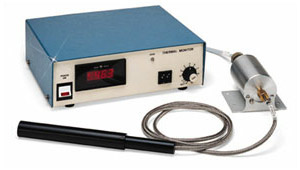
Infrared Thermocouples
An infrared thermocouple is an unpowered, low-cost sensor that measures surface temperature of materials without contact. It can be directly installed on conventional thermocouple controllers, transmitters and digital readout devices as if it were a replacement thermocouple. An infrared thermocouple can be installed in a fixed, permanent location, or used with a hand-held probe.
Because it is self-powered, it relies on the incoming infrared radiation to produce a signal via thermoelectric effects. Therefore, its output follows the rules of radiation thermal physics, and is subject to nonlinearities. But over a given range of temperatures, the output is sufficiently linear that the signal can be interchanged with a conventional thermocouple.
Although each infrared thermocouple is designed to operate in a specific region, it can be used outside that region by calibrating the readout device accordingly.
Radiation Thermometers/Pyrometers
Radiation thermometers, or pyrometers, as they are sometimes called come in a variety of configurations. One option is a handheld display/control unit, plus an attached probe. The operator points the probe at the object being measured--sometimes getting within a fraction of an inch of the surface--and reads the temperature on the digital display. These devices are ideal for making point temperature measurements on circuit boards, bearings, motors, steam traps or any other device that can be reached with the probe. The inexpensive devices are self-contained and run off battery power.
Other radiation thermometers are hand-held or mounted devices that include a lens similar to a 35mm camera. They can be focused on any close or distant object, and will take an average temperature measurement of the "spot" on the target that fits into its field of view.
Handheld radiation thermometers are widely used for maintenance and troubleshooting, because a technician can carry one around easily, focus it on any object in the plant, and take instant temperature readings of anything from molten metals to frozen foods.
When mounted in a fixed position, radiation thermometers are often used to monitor the manufacturing of glass, textiles, thin-film plastic and similar products, or processes such as tempering, annealing, sealing, bending and laminating.
Fiber Optics Extensions
When the object to be measured is not in the line of sight of a radiation thermometer, a fiber optic sensor can be used. The sensor includes a tip, lens, fiber optic cable, and a remote monitor unit mounted up to 30 ft away. The sensor can be placed in high energy fields, ambient temperatures up to 800°F, vacuum, or in otherwise inaccessible locations inside closed areas.
Two-Color Systems
For use in applications where the target may be obscured by dust, smoke or similar contaminants, or changing emissions as in "pouring metals," a two-color or ratio radiation thermometer is ideal. It measures temperature independently of emissivity. Systems are available with fiber optic sensors, or can be based on a fixed or hand-held configurations.
Linescanners
A linescanner provides a "picture" of the surface temperatures across a moving product, such as metal slabs, glass, textiles, coiled metal or plastics. It includes a lens, a rotating mirror that scans across the lens' field of view, a detector that takes readings as the mirror rotates, and a computer system to process the data.
As the mirror rotates, the line scanner takes multiple measurements across the entire surface, obtaining a full-width temperature profile of the product. As the product moves forward under the sensor, successive scans provide a profile of the entire product, from edge to edge and from beginning to end.
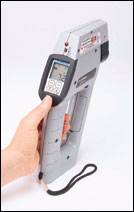
The computer converts the profile into a thermographic image of the product, using various colors to represent temperatures, or it can produce a "map" of the product. The 50 or so measurement points across the width can be arranged in zones, averaged, and used to control upstream devices, such as webs, cooling systems, injectors or coating systems.
Linescanners can be extremely expensive, but they offer one of the only solutions for obtaining a complete temperature profile or image of a moving product.
Portable vs. Mounted
Non-contact temperature measurement devices also can be classified as portable or permanently mounted. Fixed mount thermometers are generally installed in a location to continuously monitor a process. They often operate on AC line power, and are aimed at a single point. Measured data can be viewed on a local or remote display, and an output signal (analog or digital) can be provided for use elsewhere in the control loop. Fixed mount systems generally consist of a housing containing the optics system and detector, connected by cable to a remote mounted electronics/display unit. In some loop-powered designs, all the thermometer components and electronics are contained in a single housing; the same two wires used to power the thermometer also carry the 4 to 20 mA output signal.
Battery powered, hand-held "pistol" radiation thermometers typically have the same features as permanently mounted devices, but without the output signal capability. Portable units are typically used in maintenance, diagnostics, quality control, and spot measurements of critical processes.
Portable devices include pyrometers, thermometers and two-color systems. Their only practical application limit is the same as a human operator; i.e., the sensors will function in any ambient temperature or environmental condition where a human can work, typically 32-120°F (0-50°C).
At temperature extremes, where an operator wears protective clothing, it may be wise to similarly protect the instrument. In shirt-sleeve manufacturing or process control applications, hand-held instruments can be used without worrying about the temperature and humidity, but care should be taken to avoid sources of high electrical noise. Induction furnaces, motor starters, large relays and similar devices that generate EMI can affect the readings of a portable sensor.
Portable non-contact sensors are widely used for maintenance and troubleshooting. Applications vary from up-close testing of printed circuit boards, motors, bearings, steam traps and injection molding machines, to checking temperatures remotely in building insulation, piping, electrical panels, transformers, furnace tubes and manufacturing and process control plants.
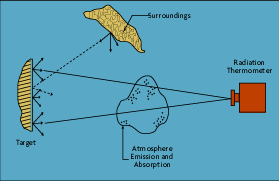
Because an infrared device measures temperature in a "spot" defined by its field of view, proper aiming can become critical. Low-end pyrometers have optional LED aiming beams, and higher end thermometers have optional laser pointing devices to help properly position the sensor.
Permanently mounted devices are generally installed on a manufacturing or process control line, and output their temperature signals to a control or data acquisition system. Radiation thermometers, two-color sensors, fiber optics, infrared thermocouples, and linescanners can all be permanently mounted.
In a permanent installation, an instrument can be very carefully aimed at the target, adjusted for the exact emissivity, tuned for response time and span, connected to a remote device such as an indicator, controller, recorder or computer, and protected from the environment. Once installed and checked out, such an instrument can run indefinitely, requiring only periodic maintenance to clean its lenses.
Instruments designed for permanent installation are generally more rugged than lab or portable instruments, and have completely different outputs. In general, systems that operate near a process are ruggedized, have NEMA and ISO industrial-rated enclosures, and output standard process control signals such as 4-20 mA dc, thermocouple mV signals, 0-5 Vdc, or serial RS232C.
For very hot or dirty environments, instruments can be equipped with water or thermoelectric cooling to keep the electronics cool, and nitrogen or shop air purging systems to keep lenses clean.
Application Guidelines
For first level sorting, consider speed of response, target size (field of view), and target temperature. Once the list of possible candidates for the application has been narrowed, consider things like band pass and sensitivity of the detector, transmission quality of the optical system and transmission quality of any windows or atmosphere in the sighting path, emissivity of the target, ambient conditions, and the process dynamics (steady state variations or step changes). These are shown graphically in Figure 8-1.
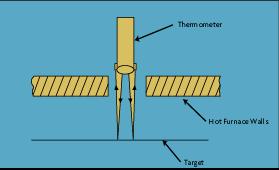
If 90% response to a step change in temperature is required in less than a few seconds, pyrometers with thermal detectors may not be suitable, unless you use thermopiles. A pyrometer with a photon detector may be a better choice.
Thermometers with targets of 0.3 to 1 inch diameter with a focal distance of 1.5 to 3 feet from the lens are common. If a target size in this range is needed to sight on a large target through a small opening in a furnace, a pyrometer in which target size increases rapidly with distance beyond the focal plane may be fit the bill. Otherwise, a thermometer with more sophisticated optics and signal conditioning may be required.
If the temperature to be measured is below 750°F (400°C) a more sophisticated pyrometer with optical chopping can improve performance.
If the surroundings between the thermometer and the target are not uniform, or if a hot object is present, it is desirable to shield the field of view of the instrument so that these phenomenon have minimal effect on the measurement.
Any radiation absorbed or generated by gases or particles in the sighting path will affect measured target temperature. The influence of absorbing media (such as water vapor) can be minimized by proper selection of the wavelengths at which the thermometer will respond. For example, a pyrometer with a silicon detector operates outside the absorption bands of water vapor and the error is nil. The influence of hot particles can be eliminated by ensuring they do not enter the sighting path, or by peak or valley picking, if they are transiently present. A open ended sighting tube, purged with a low temperature gas can provide a sighting path free of interfering particles.
Thermometers selected to measure transparent targets, such as glass or plastic films, must operate at a wavelength where the transmission of these materials is low so hot objects behind the target do not interfere with the measurement. For example, most glass is opaque at wavelengths above 5 microns if it is 3 mm or thicker. The emittance of glass decreases at higher wavelengths above 8 microns because of its high reflection, so measurement at higher wavelengths is not as desirable. If the incorrect band is picked, the thermometer will sight through the glass and not read the surface temperature.
Imagine, for example, two thermometers measuring the surface temperature of a lightbulb. One thermometer operates in the 8 to 14 micron range, and the other operates at 2 microns. The 8 to 14 micron device reads the surface temperature of the bulb as 90°C. The 2-micron device, sees through the surface of the glass, to the filament behind, and reads 494°C.
Other parameters to consider when selecting a non-contact temperature sensor include:
Target material--The composition of a target determines its emissivity, or the amount of thermal energy it emits. A blackbody is a perfect emitter, rated 1.0 or 100%. Other materials are somewhat lower; their emissivity can be anywhere from 0.01 to 0.99, or 0-99%. Organic materials are very efficient, with emissivities of 0.95, while polished metals are inefficient, with emissivities of 20% or less. Tables only give the emissivity of an ideal surface, and cannot deal with corrosion, oxidation or surface roughness. In the real world, emissivity variations range from 2 to 100% per 100°F temperature change. When in doubt, obtain an appropriate instrument and measure the emissivity exactly.
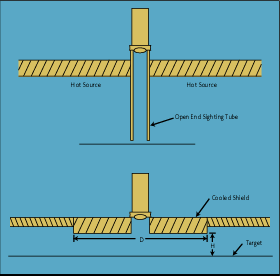 Temperature range
Temperature range--The emissivity and the range of expected temperatures of the target determine the wavelengths at which the target will emit efficiently. Choose a sensor that is sensitive at those wavelengths. Accuracy is listed as a percent of full scale or span, so the closer the temperature range to be measured can be specified, the closer sensor match, and the more accurate the final measurements.
Wavelength choice--Manufacturers typically lists their products with a given temperature range and wavelength, with wavelengths listed in microns. Note that more than one wavelength can apply in any given application. For example, to measure glass, a wavelength of 3.43, 5.0 or 7.92 microns can be used, depending on the depth you want to measure, the presence of tungsten lamps, or to avoid reflections. Measuring plastic films presents the same problems. You may want to use a broad spectrum to capture most of the radiant emissions of the target, or a limited region to narrow the temperature range and increase accuracy. In many applications, various conditions and choices may exist. You may want to consult with your supplier.
Atmospheric interference--What is present in the atmosphere between the sensor and the target? Most non-contact temperature sensors require an environment that has no dust, smoke, flames, mist or other contaminants in the sensor's line of sight. If contaminants exist, it may be necessary to use a two-color sensor. If there is an obstructed line of sight, it may be necessary to use a fiber optic probe to go around the obstacles.
Operating Environment--Into what kind of environment will the sensor itself be installed? If it is hazardous, hot, humid, corrosive or otherwise unfriendly, it will be necessary to protect the instrument. Lenses and cases are available to withstand corrosives;
air purge systems can protect lenses from process materials; and various cooling systems are available to cool the lenses, optics and electronics.
If the surrounding temperature is the same as the target temperature, the indicated temperature from a radiation thermometer will be accurate. But if the target is hotter than the surroundings, it may be desirable to use a device with a high N° value to minimize the emissivity error and minimize radiation from the surroundings reflected into the thermometer. Two approaches can be used when the target is at a lower temperature than the surroundings. The first method, Figure 8-2, is possible if the target is fixed, flat, and reflects like a mirror. The thermometer is arranged so that it sights perpendicular to the target.
To measure the temperature of a target with a matte surface, you must shield the field of view of the thermometer so that energy from hot objects does not enter. One approach, shown in Figure 8-3, involves sighting the thermometer through an open ended sighting tube. The other approach is to use a cooling shield. The shield must be large enough so that D/H ratio is 2 to 4. This method can not be used for slowly moving or stationary targets. An uncooled shield can be used to block out radiation from a small, high temperature source that will not heat it significantly.
A closed end sight tube is an accessory that can be used to protect optics and provide a clear sight path for broadband thermometers. The one end of the tube reads the same temperature as the target (it may be touching the target or very close to it), while cooling can be used to protect the thermometer itself, at the other end of the tube, from high temperatures. A closed or open end sight tube can prevent attenuation of emitted radiation by water vapor, dust, smoke, steam and radiation absorptive gases in the environment.
Industrial applications invoke either surface temperature of objects in the open, or temperatures inside vessels, pipes and furnaces. The target may need to sight through a window in the latter case. The thermometer, if permanently installed, can be mounted to an adjacent pedestal, or attached to the vessel. Hardware is available from manufacturers to accomplish this. The thermometer housing may need to be protected from excessive heat via a cooling mechanism, and/or may require a continuous clean gas purge to prevent dirt accumulation. Hardware is optionally available for both needs.
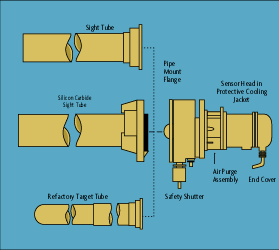
The accessories needed for difficult applications, for example, to permanently install a radiation thermometer on the wall of a furnace, can easily escalate the cost of an infrared thermometer into the thousands of dollars, doubling the price of the standard instrument. In Figure 8-4, for example, the thermocouple sensor head and its aiming tube are mounted inside a cooling jacket. The coolant flow required depends on the actual ambient conditions which exist. Also shown are an air purge assembly, and a safety shutter. The latter allows the furnace to be sealed whenever the radiation thermometer must be removed.
If the target and the surroundings are not at the same temperature, additional sensors, as shown in Figure 8-5 need to be supplied. This configuration allows automatic compensation in the radiation thermometer electronics for the effects of the surroundings on the target temperature reading.
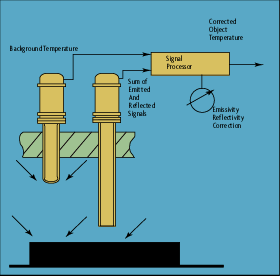
There is a lot to consider when selecting and installing a non-contact sensor to measure a critical process temperature. And to the unfamiliar, the task can seem mind boggling. How do I get emissivity data? Which wavelength(s) is best for my application? What options do I really need? .... and a thousand other questions easily come to mind. But help is available. For example, many manufacturers have open Internet sights that contain an abundance of helpful information to assist the first time user in getting started. (See list of resources, p. 68.) In addition, there are consultants, as well as the manufacturers themselves, who can supply all the assistance needed to get up and running quickly.
Industrial Applications
In most cases, at least one of the sensors we've discussed can be used to measure temperature in any kind of application, from -50 to 6,500°F . The key is to identify the sensor that will do the best job. This can be a very simple or an extremely difficult choice. Perhaps some of the applications listed below will give you a few ideas on how to use a non-contact temperature sensor in your plant.
Airplane Checkout--The sheer size and height of a widebody 747 aircraft makes it very difficult for technicians to check the operation of various devices, such as pitot tubes and heating tapes used to warm pipes, water and waste tanks in various parts of the aircraft. Before, a technician had to climb a 25-ft ladder and touch the surfaces to see if the devices were working properly.
Now, a radiation thermometer is used during final assembly to check the operation of various heating elements. The technician stands on the ground, and aims the thermometer at each pitot tube or heating element. Boeing reports saving 4-5 construction hours on each jet.
Asphalt--Asphalt is very sensitive to temperature during preparation and application. Thermocouples normally used to measure asphalt temperature usually have severe breakage problems because of the abrasiveness of the material. Infrared thermocouples are an ideal replacement.
The sensor can be mounted so that it views the asphalt through a small window in the chute, or slightly above for viewing at a distance. In either case, the sensor should have an air purge to keep the lens clean from vapor or splashes. Plus, it can be connected to the control system as if it was a thermocouple.
Electrical System Maintenance-- Infrared scanning services are becoming widely available. Typically, a scanning service brings in a portable imaging processor and scanner twice a year to check a building's switchgear, circuit breakers, and other electrical systems. The service looks for hot spots and temperature differences.
Between visits, maintenance personnel can perform spot checks and verify repairs with an inexpensive radiation thermometer. Attaching a data logger lets a technician determine heating trends of switchgear during peak periods, and identify the parts of system that suffer the most when electrical consumption goes up.
Flame Cutting--In flame cutting, before a computer cuts various shapes from steel plate, the steel surface has to be heated by a natural gas or propane flame. When a "puddle" of molten metal is detected by the operator, oxygen is injected into the gas stream. This blows the molten metal through the plate and the cutting cycle begins. If oxygen is injected prematurely, it makes a defective cut, leaving an objectionable rough and wide pit-like depression in the plate.
A fiber optic sensor can be mounted on the torch and aimed to look through the gas stream at the plate surface. It will detect the proper plate temperature for puddling, and inform the operator.
Glass--An infrared thermometer is ideal for measuring the temperature of soda-lime-silica glass, predominantly used in making sheet, plate, and bottles. The biggest problem is that glass has relatively poor thermal conductivity, so temperature gradients exist at various depths. The three most commonly used wavelengths for measuring glass--3.43, 5.0, and 7.92 microns--each see a different distance into the glass. A sensor with 7.92 microns sees only the surface, while a 3.43 micron sensor can see up to 0.3 in. into the glass.
The trick is to select a thermometer which is not adversely influenced by thickness variations. Your best bet may be to send samples of glass products to the thermometer manufacturer, and let them advise you on what device to use.
| Table 8-2: Successful Radiation Thermometer Applications |
| |
MOUNTED |
PORTABLES |
| 2 |
H |
L |
2 |
H |
L |
| Cement Kilns |
• |
• |
|
• |
• |
|
| Burning zones, preheaters |
|
|
|
|
|
|
| Energy Conservation |
|
|
• |
|
|
• |
| Insulation and heat flow studies, thermal mapping |
|
|
|
|
|
|
| Filaments |
• |
|
|
• |
|
|
| Annealing, drawing, heat treating |
|
|
|
|
|
|
| Food |
|
|
• |
|
|
• |
| Baking, candy-chocolate processing, canning freezing, frying, |
|
|
|
|
|
|
| mixing, packing, roasting |
|
|
|
|
|
|
| Furnaces |
• |
• |
|
• |
• |
|
| flames, boiler tubes, catalytic crackers |
|
|
|
|
|
|
| Glass |
• |
• |
• |
• |
• |
• |
| Drawing, manufacturing/processing bulbs, containers, |
|
|
|
|
|
|
| TV tubes, fibers |
|
|
|
|
|
|
| Maintenance |
|
|
• |
|
|
• |
| Appliances, bearings, currentoverloads, drive shafts, insulation, |
|
|
|
|
|
|
| power lines, thermal leakage detection |
|
|
|
|
|
|
| Metals (ferrous and nonferrous) |
• |
• |
|
• |
• |
|
| annealing, billet extrusion, brazing, carbonizing, casting, |
|
|
|
|
|
|
| forging, heat treating, inductive heating, rolling/strip mills, |
|
|
|
|
|
|
| sintering, smelting |
|
|
|
|
|
|
| Metals, Pouring |
• |
|
|
|
|
|
| Quality Control |
• |
• |
• |
• |
• |
• |
| printed circuit boards, soldering, universal joints, |
|
|
|
|
|
|
| welding, metrology |
|
|
• |
|
|
|
| Paint |
|
|
|
|
|
|
| Coating, ink drying, printing, photographic emulsions, web profiles |
|
|
• |
|
|
• |
| Paper |
|
|
|
|
|
|
| Blow-molding, RIM, film extrusion, sheet thermoforming, casting |
|
|
• |
|
|
• |
| Plastic |
|
|
|
|
|
|
| Blow-molding, RIM, film extrusion, sheet thermoforming, casting |
|
|
• |
• |
|
• |
| Remote Sensing |
|
|
|
|
|
|
| Clouds, earth surfaces, lakes, rivers, roads, volcanic surveys |
|
|
• |
|
|
• |
| Rubber |
|
|
|
|
|
|
| Calendaring, casting, molding, profile extrusion, tires, latex gloves |
• |
|
• |
• |
|
• |
| Silicon |
|
|
|
|
|
|
| Crystal growing, strand/fiber, wafer annealing, epitaxial deposition |
|
|
• |
|
|
• |
| Textile |
|
|
|
|
|
|
| Curing, drying, fibers, spinning |
• |
|
|
• |
|
|
| Vacuum Chambers |
|
|
|
|
|
|
| Refining, processing, deposition |
|
|
|
|
|
|
| 2=2-color sensor H=High Temperature L=Low Temperature |
During installation, select the aiming point so that the instrument doesn't see any hot objects behind the transparent glass, or any reflected radiation from hot objects in front of the glass. Aim the sensor at an angle that avoids reflections, or install an opaque shield to block the reflections at the source. If neither is possible, use either of the higher wavelength sensors, because they are not affected as much by reflections.
Be careful of applications where the glass is heated with high intensity, tungsten filament quartz lamps. These generate radiation levels that interfere with thermometers operating below 4.7 microns. In this case, use a 7.92 micron sensor.
Glass Molds--The temperature of the mold or plunger used to make glass containers is critical: if too hot, the container may exit the mold and not retain its shape; if too cool, it may not mold properly. Molds must be measured constantly to ensure that cooling is proceeding correctly.
An infrared thermometer can be used to take mold measurements. A few suggestions: Don't measure new molds. They are usually shiny and clean, so they are reflective and have low emissivity. As they get older, they get dull and non-reflective, and the emissivity becomes higher and more repeatable. Use a radiation thermometer with a short wavelength, such as 0.9 microns, or a two-color instrument.
Humidity--An infrared thermocouple can be used to measure relative humidity in any situation where there is a convenient source of water and flowing air. Aim the device at a wet porous surface with ambient air blowing across. When air moves across a wet surface, water cools by evaporation until it reaches the wet-bulb temperature, and cooling stops. The sensor can be connected to a display that records the lowest temperature, which is the wet-bulb temperature, and can be used to calculate the relative humidity.
Immersion Thermowells--Thermowells protrude into a high-pressure vessel, stack, pipe or reactor, allowing a temperature sensor to get "inside" while maintaining process integrity. An infrared thermocouple or fiber optic sensor can be positioned outside the thermowell looking in, rather than being mounted inside the thermowell. Conventional sensors subjected to constant high temperatures suffer metallurgical changes that affect stability and drift. But the non-contact sensors, because they are outside, do not suffer such problems. They also respond more quickly; essentially, the response time of a radiation sensor is the same as the thermowell. Also, since the sensor is outside, it will survive much longer in a very high temperature environment than a conventional sensor will.
| Table 8-3: Typical Application Temperature Ranges |
| APPLICATION |
TEMP. RANGES |
General purpose for textile, printing, food, rubber, thick plastics, paints,
laminating, maintenance |
-50 to 1000°C
-58 to 1832°F |
| Life sciences, biology, zoology, botany, veterinary medicine, heat loss and research |
0 to 500°C
32 to 932°F |
| Thin film plastic, polyester, fluorocarbons, low temperature glass |
50 to 600°C
122 to 1112°F |
| Glass and ceramic surfaces, tempering,annealing, sealing, bending and laminating |
300 to 1500°C
572 to 2732°F
|
| See-through clean combustion flames and hot gases. Furnace tubes
|
500 to 1500°C
932 to 2732°F |
| Medium to high temperature ferrous and non-ferrous metals. See-through glass
|
250 to 2000°C
482 to 3632°F |
| Hot and molten metals, foundries, hardening, forging, annealing, induction heating |
600 to 3000°C
1112 to 5432°F |
To install a radiation thermometer in a thermowell, mount it so it is aimed directly into a hollow thermowell, and adjust its distance so that its "spot size" is the same diameter as the thermowell. This way, the sensor will monitor temperature at the thermowell tip. If the thermowell has a sight glass, select a sensor that can see through it.
Induction Heating--Measuring the temperature of an induction heating process can be accomplished with infrared thermocouples, thermometers or fiber optic sensors.
An infrared thermocouple will operate in the very strong electrical field surrounding induction heaters. Make sure the sensor's shield wire is attached to a proper signal ground. The preferred method is to view the part between the coil turns or from the end. If there is excessive heating on the sensor, use a water cooling jacket (you can use the same water source used to cool the induction coil).
Fiber optic sensors should be mounted so the viewing end is placed close to the target. The tip of the fiber can be positioned between the induction coils. Replaceable ceramic tips can be used to minimize damage and adverse effects from the radio frequency field. If the fiber won't fit, use a lens system to monitor the surface from a distance. Fiber optic sensors are not normally affected by induction energy fields, but if the noise is excessively high, use a synchronous demodulation system. The demodulator converts the 400 Hz ac signal from the detector head to dc, which is more immune to noise.
Plastic Film--A film of plastic or polymer emits thermal radiation like any other material, but it presents unique measuring problems for any sensor, including a radiation thermometer. As with glass, when measuring film temperature, it's important to install it so the instrument doesn't see any hot objects behind the transparent film, or any reflected radiation from hot objects in front of the film.
For films of 1, 10 or 100 mil thicknesses, a wavelength of 3.43 or 7.92 microns will work for cellulose acetate, polyester (polyethylene terephthalate), fluoroplastic (FEP), polymide, polyurethane, polyvinyl chloride, acrylic, polycarbonate, polymide (nylon), polypropylene, polyethylene and polystyrene.
As with glass, be careful of applications where the film is heated with high intensity, tungsten filament quartz lamps. These generate radiation levels that interfere with thermometers operating below 4.7 microns. In this case, use a 7.92 micron sensor.
Web Rollers--Infrared sensors can be used to measure the temperature of rollers used in various web processes, even if they are chrome plated. Uncoated metal or chrome rollers are difficult for an IR sensor to see, because they have low emissivity and the sensor sees too many environmental reflections. In such a case, paint a black stripe on an unused portion of the roller and aim the device directly at the stripe.
Dull metal rollers often provide reliable signals. Emissivity can shift if the rollers get covered with dirt, moisture or oil. If in doubt, simply paint a stripe. Non-metallic surfaced rollers provide a reliable signal no matter where the device is pointed.
| Table 8-4: Application Wavelengths (Microns) |
TYPICAL
APPLICATIONS |
0.65 |
0.9 |
1.0 |
0.7-1.08
and
1.68
2-color |
1.55
and
1.68
2-color |
1.65 |
2.0 |
3.43 |
3.9 |
5.0 |
7.9 |
8-14 |
| Aluminum |
|
|
• |
|
• |
• |
• |
|
|
|
|
|
| Asphalt |
|
|
|
|
|
|
|
|
|
• |
• |
|
| Automotive |
|
• |
• |
• |
• |
• |
• |
• |
|
|
• |
• |
| Appliances |
|
|
|
|
|
|
• |
• |
|
|
• |
• |
| Ammunition |
|
|
|
|
|
|
• |
• |
|
|
|
• |
| Batteries |
|
|
|
|
|
|
• |
|
|
|
|
• |
| Cement |
• |
• |
• |
• |
|
|
• |
|
• |
|
• |
• |
| Construction Materials |
|
|
|
|
|
|
• |
|
|
• |
• |
|
| Fiberglass |
• |
|
• |
• |
|
|
• |
• |
|
• |
|
• |
| Food Processing |
|
|
|
|
|
|
• |
• |
|
|
|
• |
| Foundry |
• |
• |
• |
• |
|
|
• |
|
|
|
|
|
| Glass-Melting |
• |
• |
• |
• |
|
|
|
|
• |
|
|
|
| Glass-Flat |
|
|
|
|
|
|
|
|
• |
• |
|
|
| Glass Bottles |
|
• |
|
|
|
|
|
|
• |
• |
• |
|
| Heat Treating |
|
• |
|
• |
• |
• |
|
• |
|
|
|
|
| Induction Heating |
|
• |
|
• |
• |
• |
|
• |
|
|
|
|
| Kilns |
• |
• |
|
• |
|
|
• |
|
• |
• |
|
• |
| Metalworking |
|
• |
|
• |
• |
• |
|
• |
|
|
|
|
| Mining |
|
|
|
• |
|
|
|
|
|
|
|
|
| Non-ferrous Metals |
|
|
• |
|
• |
• |
|
• |
|
|
|
|
| Ovens |
|
• |
• |
• |
• |
• |
• |
• |
• |
• |
• |
• |
| Paper |
|
|
|
|
|
|
• |
|
|
• |
• |
|
| Pharmaceutical |
|
|
|
|
|
|
|
|
|
|
• |
|
| Plastics |
|
|
|
|
|
|
• |
|
|
• |
• |
|
| Plastic Films |
|
|
|
|
|
|
|
• |
|
|
• |
|
| Rubber |
|
|
|
|
|
|
|
|
|
• |
• |
|
| Semiconductors |
|
• |
• |
• |
• |
|
• |
|
• |
• |
|
|
| Steel |
• |
|
• |
• |
|
• |
|
• |
|
• |
|
|
| Textiles |
|
|
|
|
|
|
• |
• |
|
|
• |
• |
| Utilities |
|
|
|
• |
|
|
|
|
|
|
• |
|
 CLOSE
CLOSE







